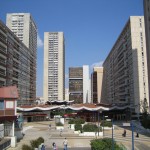On Friday 13th November, 2015 six public spaces across Paris were the site of a series of co-ordinated attacks resulting in the loss of 128 innocent lives and 180 people injured. The Islamic State in Iraq and Syria (ISIS) claimed responsibility for the attacks. These events of anger and violence are still taking place despite the high levels of security, surveillance and border controls in European nations. It is becoming clear that these are not external attacks. They are a symptom of deep dissatisfaction with the way European societies are failing to accept other cultures within their own borders. Inflamed by European foreign policy that is still deeply entrenched in a neo-imperialist narrative of superiority, land, resources, and power, these attacks are a response to injustice, inequality, and deep prejudices in European cosmopolitan cities.
There is already a great deal of evidence on the unequal spatial and economic distribution of cultural groups in so-called ‘ghettoes’ and ‘ethnic enclaves’ in the European city. In Paris alone, the outer suburbs, banlieue, and the two Chinatowns in Quartier Chinois in the 13th arrondissment, and the other in Belleville, are just some examples of ‘ethnic enclaves’. In October and November 2005 the banlieue were the site of riots driven by high youth unemployment and police harassment. It is in these segregated spaces where discontent breeds.
In my book ‘Bridging Cultures: the guide to social innovation in cosmopolitan cities’ I discuss the impact of these inequalities and prejudices on the low levels of trust, good will, reciprocity, fellowship and sympathy that binds a society together. I highlight the importance of public spaces as an arena for building these values and bridging between cultures. The public spaces used for the Paris attacks cannot be inclusive spaces, otherwise they would not have been targeted. The Stade de France, four restaurants, a bar, and the Bataclan concert hall are located in areas of affluence, reinforce perceptions of ‘us’ and ‘them’, and/or cost money to be there. They are the types of public spaces that some cultures don’t feel they can engage.
There is no single definition of inclusive public space, however, commentators define four dimensions of accessibility:
- Physical access allows people to be physically present with no barriers to getting in to the space and moving in and through it regardless of age and ability
- Social access (or ‘symbolic access’) involves the presence of cues, in the form of people, design and management elements, suggesting who is and who is not welcome in the space
- ‘Visual access’ or ‘visibility’ of public spaces use symbols, or landmarks, within these spaces and provide a feeling of safety and comfort, as well as belonging
- Access to activities where public space provides a diverse and multifunctional range of activities that meets the needs of diverse cultures, genders, abilities and ages
More accessible public spaces promote sociability and the ‘circumstances’ for social encounters that bridge between cultures. The well-established Project for Public Spaces (PPS) describes good places as places that offer people many different reasons to go there. They are places where we want to ‘hangout’ for some time because the place offers us a variety of activities, experiences, and comfort. These places are clearly identifiable from a distance, easy to enter when you get closer, and simple to use. Taking this idea of ‘hangouts’ one step further, Ray Oldenburg, in his seminal book The Great Good Place: cafes, coffee shops, bookstores, bars, hair salons and other hangouts at the heart of the community, defines the core qualities of those ‘hangouts’. He calls them ‘third spaces’, or public spaces that host the regular, voluntary, informal and happily anticipated gatherings of individuals beyond the realms of home and work. He describes their qualities as:
- Being ‘neutral ground’, where individuals can come and go as they please
- Being highly inclusive, accessible and without formal criteria of membership
- Their ‘taken-for-granted-ness’ and low profile
- Being open during and outside office hours
- Being characterised by a ‘playful mood’
- Providing psychological comfort and support
- With conversation their ‘cardinal and sustaining’ activity, providing ‘political fora of great importance’
These are the types of spaces where people can enjoy the social vibrancy of urban life and seeing other people. They can also be places of retreat and relief from dense urban districts and structured everyday life. Places of retreat, such as parks, a cemetery, or footpaths that are close to water, provide opportunities for reflection. Markets and neighbourhood spaces provide the spaces for meeting friends and support networks. Both types of third places support well-being and have therapeutic functions.
But public spaces are more than just containers of human activity. They are also collective expressions of a city, as well as depositories of personal memories. Recollections of using a space when growing up, for example, could promote a sense of belonging, or prompt fond family memories. As places where important historical events tend to unfold, public spaces are imbued with important, collective meanings – both official and unofficial. People need a variety of public open spaces within a local area to meet a range of everyday needs: spaces to linger as well as spaces of transit; spaces that bring people together as well as spaces of retreat; green spaces as well as hard spaces such as streets or markets.
To what extent does Paris, and other European cosmopolitan cities, provide the number and range of public spaces that truly encourage social mixing and better cross-cultural understanding? And you may ask why is social mixing necessary? The case for social mixing is set out in Landry and Wood’s The Intercultural City. They mention a number of benefits for social mixing:
- Social mixing nurtures a spirit of emulation, motivates those less affluent, and provides greater opportunity for people to exercise choice to climb the social and economic ladder
- Livng in close proximity with those of different social and economic backgrounds stimulates a more competitive aesthetic standard
- Socially mixed residential neigbourhoods promote intellectual and cultural cross-fertilisation leading to greater tolerance
- Mixing promotes social harmony by reducing social and racial tensions as a result of greater communication through interaction and raising levels of trust and greater understanding
- Mixing promotes social conflict considered important to individual psychological growth where disharmony can be reconciled
- Mixed residential areas improve the physical functioning of the city because different income groups support civic infrastructure
- A high degree of diverse facilities and housing types in a neighbourhood supports social stability
In my view, what European cosmopolitan cities can learn from the Paris attacks, is to tackle the social, economic and spatial inequalities in the city, starting with bridging cultures and raising intercultural awareness. One of the basic rationales is that prejudice may be reduced as one learns more about different cultures. Placing people into contexts where they become more empathetic to members of other cultural groups is one method that has shown considerable success in reversing prejudice. By imagining themselves in the same situation, people are able to think about how they would react and gain a greater understanding of other people’s actions.
Several commentators have suggested that it is the horizontal relationship between citizens, residents and local people with each other at the scale of the neighbourhood which creates a wider sense of common interest. People need to share things in common in order to live together. Several factors, in particular, are critical:
- Trust: people must trust one another to comply with the rules
- Solidarity: people must still recognise the value of contributing to the common good even when they don’t directly benefit as a result
- Empowerment: People feel they have a voice which is listened to and are involved in processes that affect them. They have the power to take actions and initiate change themselves
- Participation: people take part in social and community activities
- Associational activity and Common purpose: people co-operate with each other through the formation of formal and informal groups to further their interests
- Supporting networks and reciprocity: People and organisations co-operate to support one another for either mutual or one-sided gain. An expectation that help would be given to or received from others when needed
- Collective norms and values: people share common norms and values. They tolerate and respect other people’s norms and values.
- Safety: people feel safe in their neighbourhood and are not restricted in their use of public space by fear
- Belonging: people feel connected to their neighbours and place
We know that public spaces are vitally important for nurturing tolerance because they are where people often encounter one another. These values, such as trust and solidarity, are often built partly through familiarity. The gradual breaking down of the barriers of ‘otherness’, and the recognition of shared interests and a common humanity between strangers builds familiarity over time. For the same reason, the places where people interact with the state plays an essential part in building people’s trust in the state. When it comes to diversity and change, particularly in communities which are experiencing tensions and rapid rates of mobility, trust becomes an essential element for building relationships. I would assert that in Paris, as in other European cosmopolitan cities, too much attention has been focused on defining who belongs and who doesn’t, rather than finding creative ways to build a tolerant and cohesive society.
Noha is author of ‘Bridging Cultures: A guide to social innovation in cosmopolitan cities’.
Bridging Cultures is available on Amazon at: http://www.amazon.co.uk/Bridging-Cultures-Social-Innovation-Cosmopolitan/dp/1517157188

